The year was 1988, and Gainax wasn't doing so well.
A pack of college students and anime fans, they'd gone from making parody clips for anime conventions to founding their own studio and talking Bandai into letting them make Japan's most expensive animated film to date: The Wings of Honneamise. And then they'd watched as it nearly bankrupted them.
Gainax wanted a hit, and they took no chances with their next project. Honneamise was and still is a risky, often entrancing film about alternate-world astronauts, but Gunbuster would be a cheaper direct-to-video series stocked with the things that anime geeks of the ‘80s adored most: cute girls, classic science fiction, and massive robots.
All of those meet at an Okinawa high school in 2023, where Gunbuster's amusing opening scene shows a gym class full of teenage girls piloting chubby robots as part of their space-pilot training. Noriko Takaya has better cause to be there than most of her classmates: her high-ranking military father was killed in mankind's first encounter with a mysterious alien race. Yet she's also absent-minded and has only one friend at the school, with the other students either mocking her clumsiness or detesting her privileged background.
Noriko's motivation arrives one day with encouraging words from the elegant, detached ace student Kazumi Amano, and a far more severe lecture from the school's stern, sunglasses-wearing coach Koichiro Ota, a former crewmate of her father. While Noriko bumbles her way through classes, Ota shocks the school by naming her as Kazumi's partner in the military's robot-piloting Top Squadron. Noriko's shaken at first, but after rigorous training and a fight with one of her classmates, she's headed up to join the elite.
For an allegedly iconic series, Gunbuster starts off without much substance. Though it's a well-directed and often funny parody of sports movies and older anime (most obviously the tennis-based shojo classic Aim for the Ace!), the first episode spends far less time developing its setting than it does on panning over Noriko in her skimpy, uncomfortable-looking gym outfit. We're clearly supposed to root for our downtrodden heroine, but her dumb mistakes, mawkish outbursts, and huge quivering eyes are frequently more cloying than sympathetic.
Noriko grows up only a little by the second episode, where she reaches the Top Squadron's orbital training station and watches Kazumi clash with the resident alpha, a cocky, red-haired Russian girl named Jung-Freud. Their robot-fueled fight takes them across the training facility and nets them a glimpse of the enemy: a race of enormous deep-space insects. Noriko makes friends with Jung-Freud, Kazumi icily acknowledges her, and everything seems headed for that unremarkable place where lightweight sci-fi war stories go to slowly die.
And then something changes.
At the end of the second episode, Noriko, Kazumi and Ota investigate an unidentified chunk of space debris. It turns out to be the wreck of the ship commanded by Noriko's father, and with only the slightest hint that he might still be alive, daddy's little whiner loses control and goes stomping through the ship's corridors, shrieking for her papa. All of sudden, Noriko's insecurities are laid bare, her childish breakdowns are much easier to understand, and Gunbuster makes sense.
It's here that the series finds its feet. On the front lines of an increasingly desperate war, Noriko's shunned by her teammates and forced to watch comrades die, and while she's as whiny as ever, it works. Her fragile state and perpetual self-doubt are only a microcosm of mankind's battle against a horrifyingly more powerful race of space insects, and it's all a buildup to the moment where she takes charge of the massive giant robot that gives Gunbuster its title. It's one hell of a moment, all desperate combat and booming score, and the series only improves from there. The battles get bigger and grander as personal struggles clash with the looming conflict, leading up to a finale, letterboxed and rendered in striking black-and-white tones, that's among the most powerful I've seen in anime. I suspect Gainax stole it from somewhere else, but I prefer not knowing for sure.
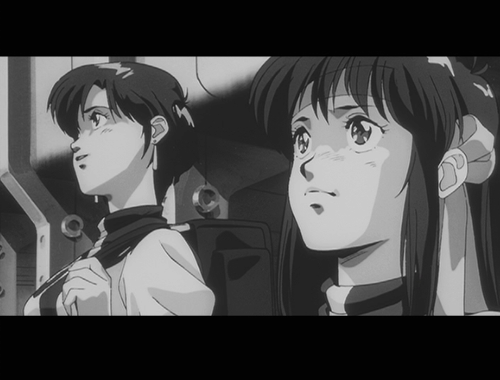
|
|
Contrary to rumor, Anno wanted the episode in black-and-white for effect, not because it was cheaper. Which it actually wasn't.
|
And whether it's mocking schoolgirl sports dramas or fashioning the interstellar equivalents of World War II naval battles, Gunbuster is worth watching just for its spectacular overkill. The animation's clearly old, but the details remain impressive, and the soundtrack is excellent, bombastic stuff. The Gunbuster itself is perhaps the coolest giant robot ever created, a hulking marvel that captures two decades of mecha culture with its wealth of ridiculous attacks, including finger missiles, homing lasers (?) and a “Buster Shield” cape. It's only the most obvious of many tributes, which run from nods to Heinlein and Blade Runner to an Ultraman homage. Even the opening music is a cheerful, wondrously inane pop trinket.
Yet it's not all one big joke. Beneath the gloriously stupid robot battles and the low-gravity bath scenes of Noriko and her fellow pilots, Gunbuster captures a darker strain of classic pulp. The military uses faster-than-light travel and other theoretical science (all detailed in amusing little bonus clips) to traverse the galaxy, and the effects are straight out of Joe Haldeman's The Forever War. And there's no pat resolution as Noriko watches her friends grow old while time dilation keeps her a teenager, fated to outlive most of the people she's trying to protect.
While there are echoes of both Honneamise and Gainax's original Daicon comedy shorts throughout the series, it's perhaps most telling that a lot of Gunbuster's staff worked on Hayao Miyazaki's Nausicaä of the Valley of the Wind, which shows up on the walls of Noriko's room, alongside My Neighbor Totoro. Like Nausicaä, Gunbuster is a rough and unclouded creation from animators taking unsure steps into a vision of their own, and though it's almost a bit too earnest at times, the thematic innocence of it all is engaging.
Gunbuster's also useful as an early look at what that staff would later accomplish: Director Hideaki Anno borrowed a lot of its ideas when he shook the industry with Neon Genesis Evangelion, while producer and uncredited co-writer Hiroyuki Yamaga turned Gainax into a major anime studio. Mahiro Maeda, who provided everything from mechanical specs to Gunbuster's Ghibli-esque ending artwork, went on to helm Blue Sub No. 6 and Gankutsuou, and even the Gunbuster's designer, Koichi Ohata, came into a directing career, albeit one that involved M.D. Geist and Cybernetics Guardian.
Yes, not every part of Gunbuster's legacy is flattering. Yamaga and Anno have never been as high-minded (or as annoyingly repressed) as Miyazaki, and if they were temperate in Honneamise, they let it all loose here. With its frequent scenes of Noriko, Jung-Freud and other female pilots jiggling around in the ridiculous gym leotards they wear even into combat, Gunbuster singlehandedly coined the term “Gainax Bounce” and set the stage for generations' worth of over-busty anime women. Gunbuster and its struggling, insecure, watery-eyed heroine also pioneered the idea behind “moe,” the currently widespread trend of anime, manga, and videogames that revolve around young and grotesquely cute heroines. It's an annoyance throughout the series, even if blaming Gunbuster for modern anime's failings is like blaming the Ramones for Blink 182.
Bandai Visual's DVD edition of Gunbuster is solid enough, despite the lack of an English dub. There's a decent collection of extras, including explanatory shorts and two relatively new science-lesson clips by FLCL director Kazuya Tsurumaki. Some fans shunned the DVD after Bandai replaced the music in the first episode's two-minute training montage due to its too-close parody of Chariots of Fire, but it's a negligible problem, and the new music is actually better.
For all of its initial stumbling and nonsense, Gunbuster is still the hit that Gainax wanted, and in ways they perhaps never intended. Much like bleating, troubled little Noriko herself, it transcends its lowly origins, becoming both a resonant, hard-science character study and a glorious rush of all that's good about giant robots and space opera. More than a simple financial success, Gunbuster's an enduring triumph.
Gunbuster Versus Battle
Bandai Visual's tried almost a bit too hard to set up its Honneamise label as the anime equivalent of Criterion releases: high-grade, extras-laden editions of classic movies. It's a nice addition to this little subculture, and while their debut titles, the first two Patlabor films, were stocked with a ridiculous excess of features (who needs the entire film's storyboards?), Gunbuster is a shade more modest.
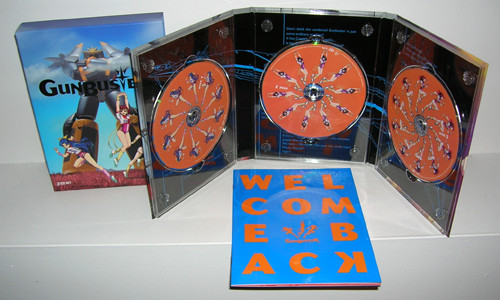
|
|
The only problem? The discs tend to come loose during shipping.
|
Instead of thick tomes of background information, Gunbuster includes only a 24-page booklet with an in-joke right on the cover. Edited by monumental Gunbuster fan Carl Horn, the liner notes within are a decent guide to the series, though a lot of it's aimed squarely at the Gunbuster faithful, and the text sometimes veers toward the rapture of mental illness. An excerpt: “There is one thing to say about the touching monochrome of the finale. If you are an otaku, you will see some kind of salvation in that moment. If you are an otaku, you grew up baptized, in the undiluted solutes of SF …anime …tokusatsu.”
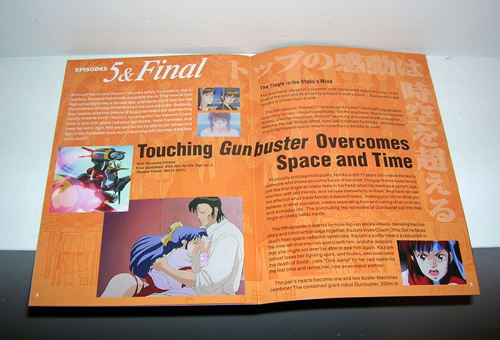
|
|
Touching Gunbuster is illegal in twelve states.
|
The booklet doesn't have anything in the way of interviews, and that's a disappointing omission, considering that interviews were the most interesting part of those heavy Patlabor box sets. For Gunbuster, the best extras are the bonus clips, especially one that shows Jung-Freud getting her own overpowered robot and a crazed fangirl to go with it.
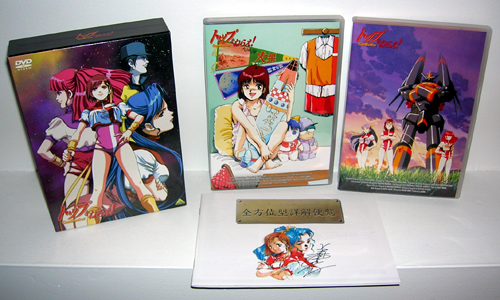
|
|
I like the art on the far right case better than what they used on the U.S. DVD cover. The art on the outer case, however, just screams LOOK AT NORIKO'S CROTCH.
|
The Japanese version is a slight improvement. It's a bit sturdier, shows off more artwork and, most importantly, has an extra disc that was excised completely from the American release. Perhaps realizing that some American fans are nuts enough to want everything, Bandai Visual brought out a region-free version of the Japanese Gunbuster DVD in the U.S. a few months before the official domestic version hit. It was a fairly limited release, available only at the eight or nine Kinokuniya bookstores in the country, and it was supposedly pulled from shelves once the official English version became available.
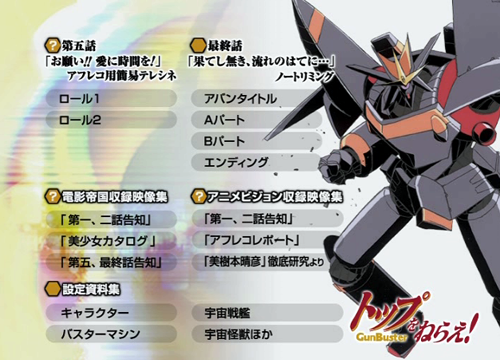
|
|
Maybe there's some hidden feature if you click on the Gunbuster's crotchplace, but I didn't find anything.
|
Some believe that Bandai yanked the fourth disc from the U.S. release to prevent Japanese fans from importing it, but the extras included aren't terribly interesting: a rough-cut version of the fifth episode, an uncropped version of the sixth, a gallery of artwork, and a handful of trailers, ranging from basic promos to interviews with Gunbuster's three lead voice actresses.
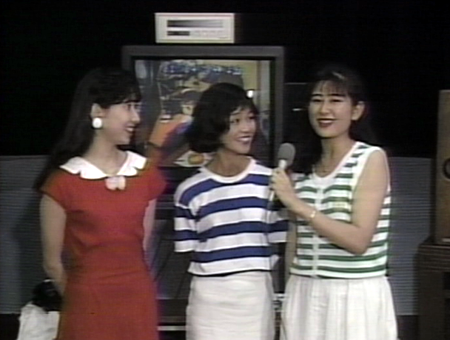
|
|
Wait, they can't be real people! They're CARTOONS! All the magic is gone.
|
There's also a flimsy booklet full of storyboard information, which covers both the robots and the gratuitous sunbathing of Gunbuster.

|
|
Freud's spinning in his grave, but Jung's probably just laughing his head off.
|
Another notable difference: the first episode's Chariots of Fire parody music, which Bandai replaced in the U.S. version, is fully intact in the Japanese release. There's also an extra trailer that was cut from the American version, perhaps because it also contains the potentially lawsuit-inducing music. All things considered, the loss of the fourth disc (and the Chariots mockery) is nothing that merits gnashing of teeth or paying the $100 that the region-free Japanese DVD will run you.
I'm just disappointed that neither version comes with a Noriko punching puppet.